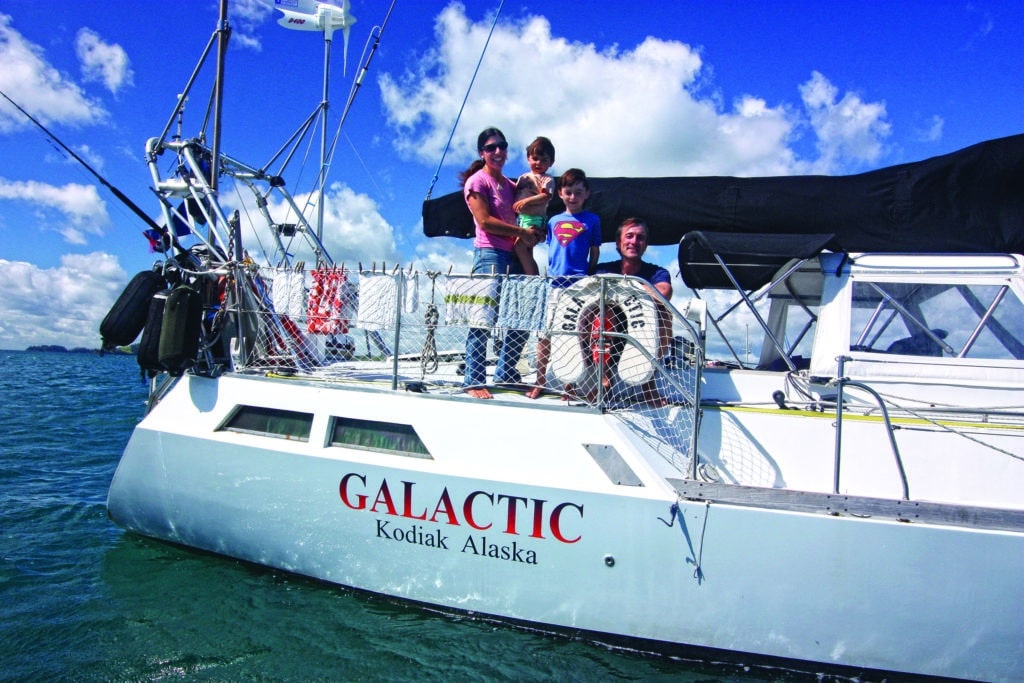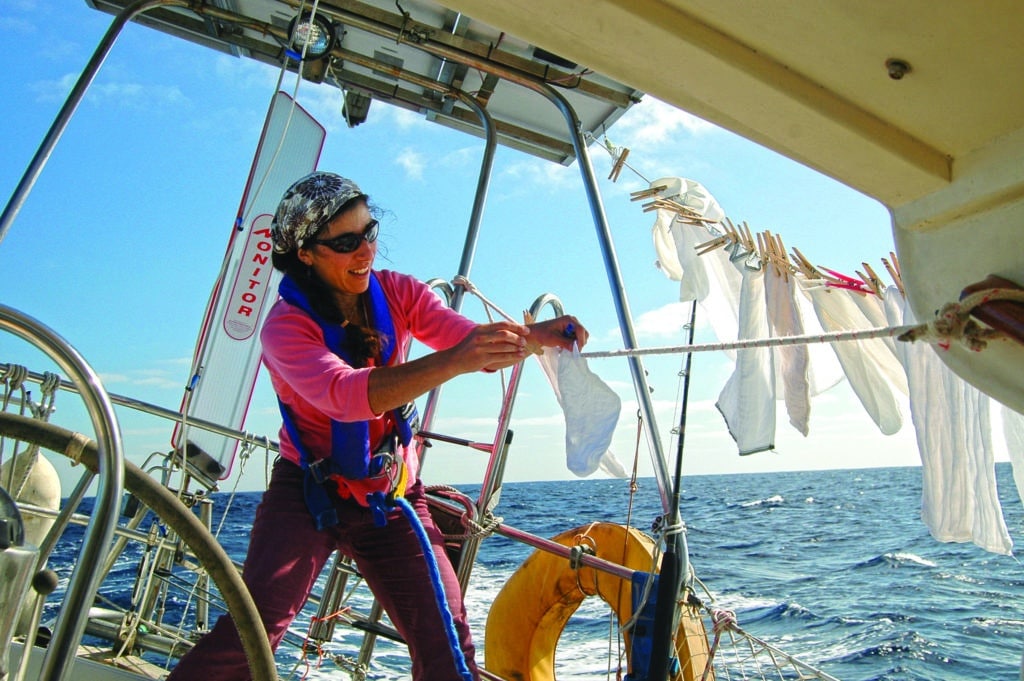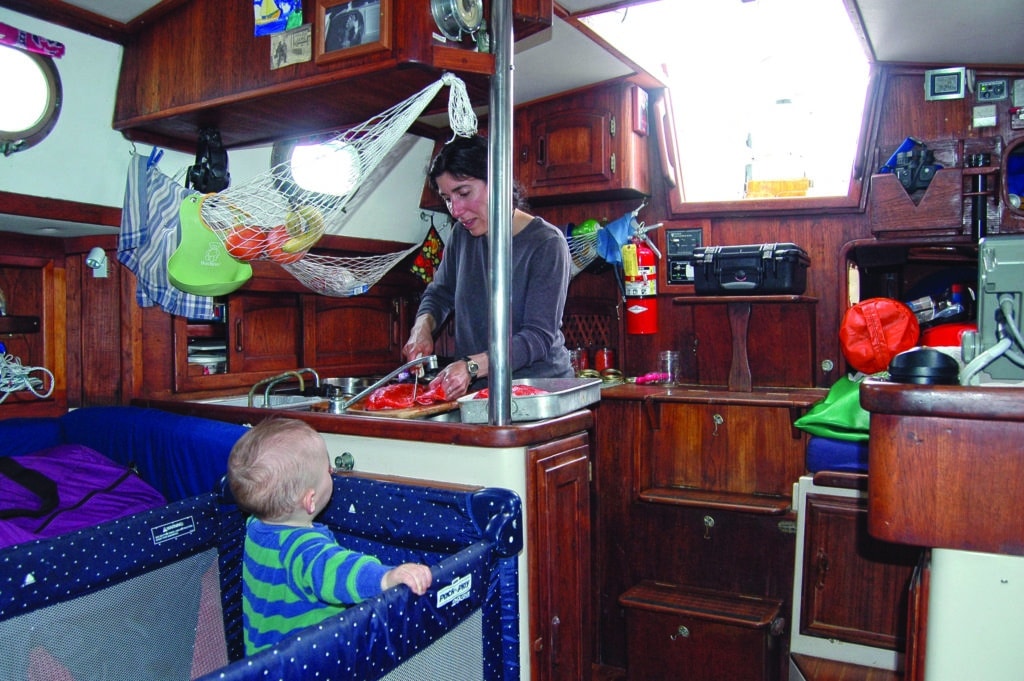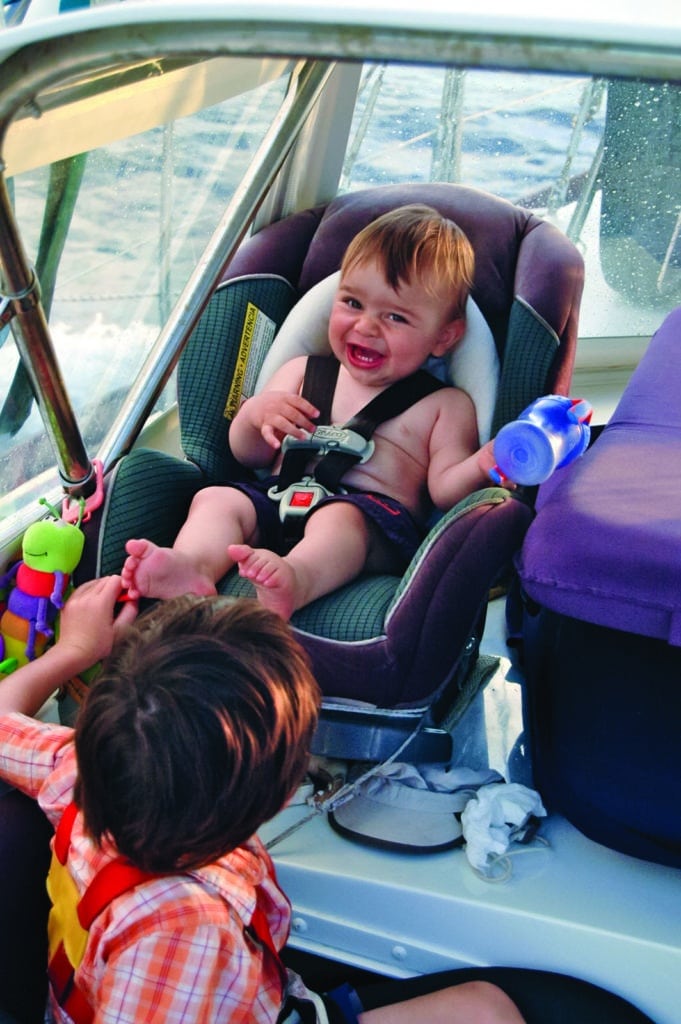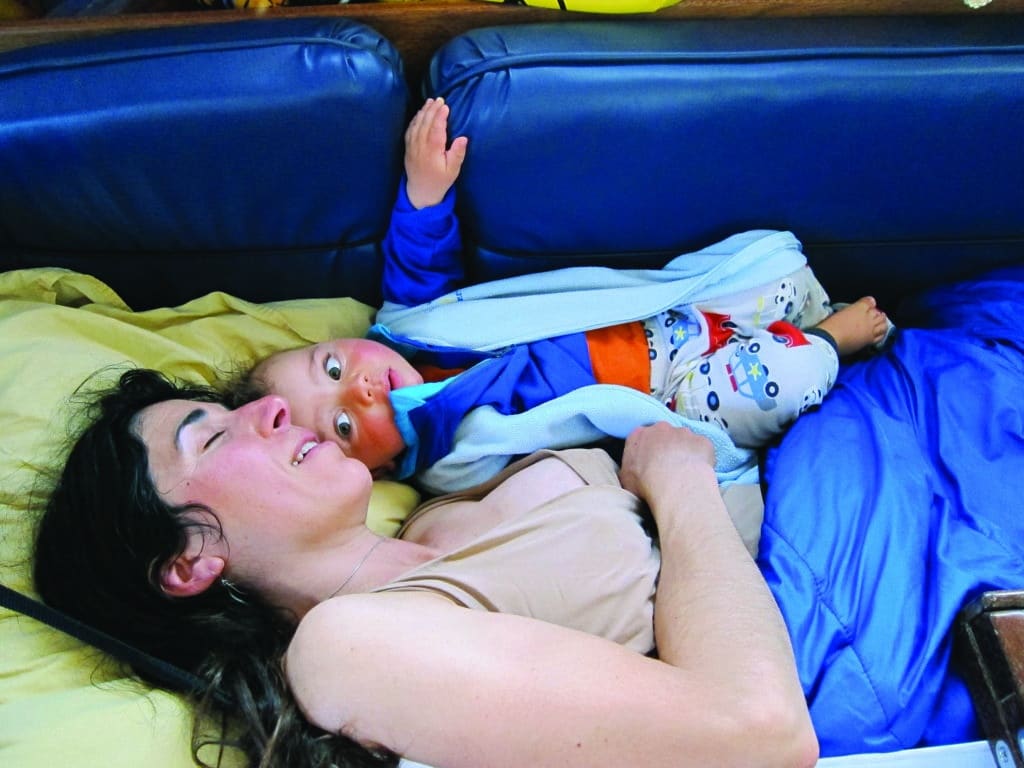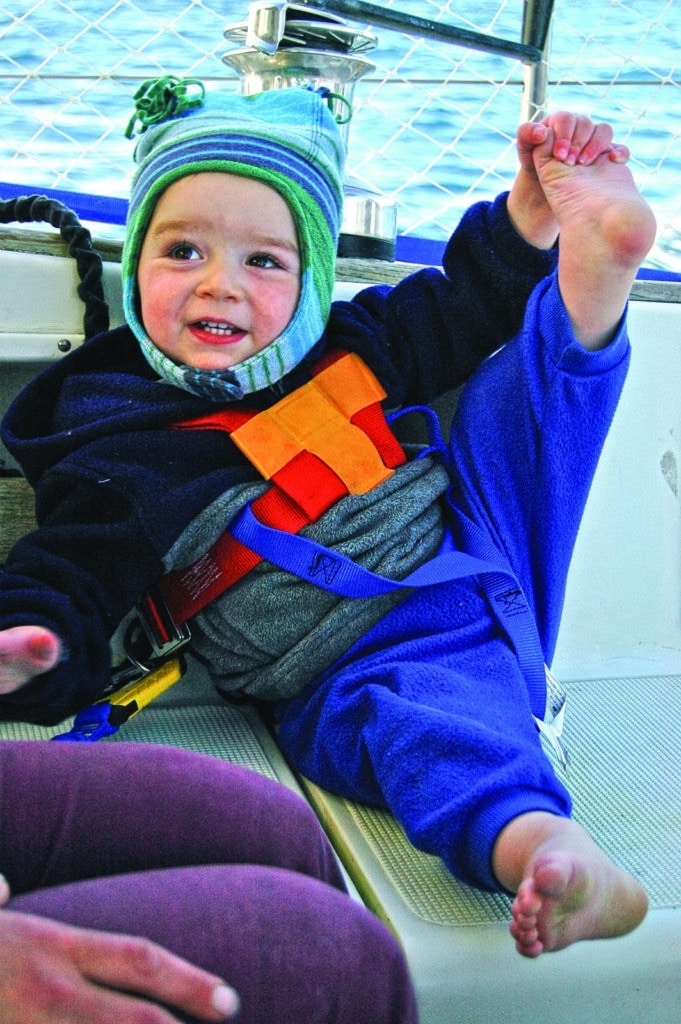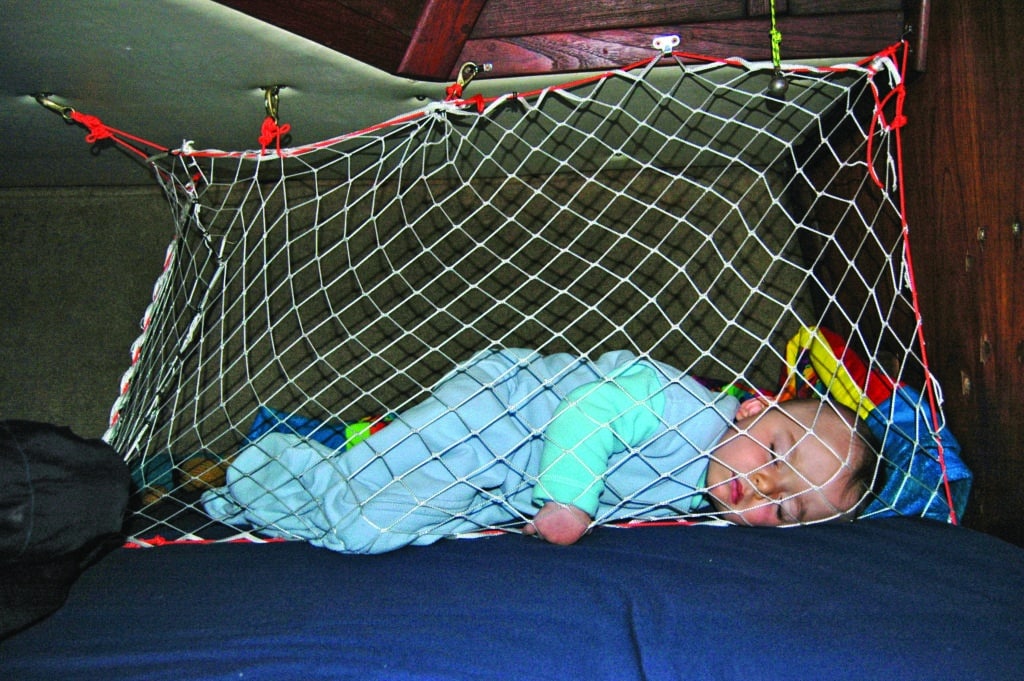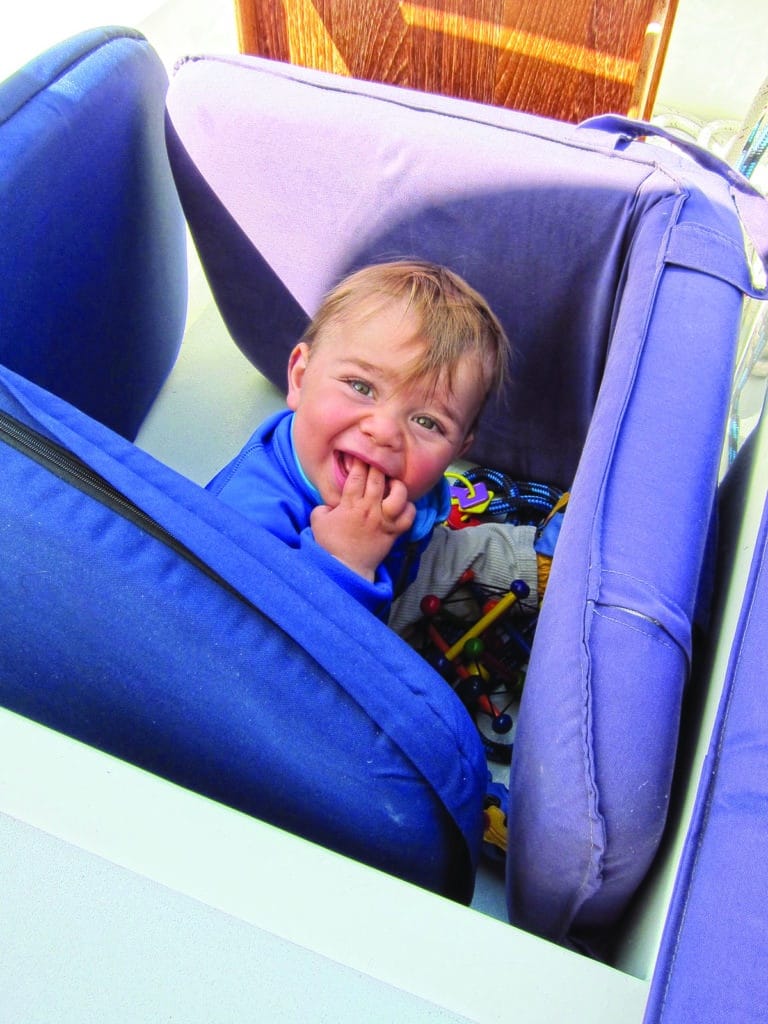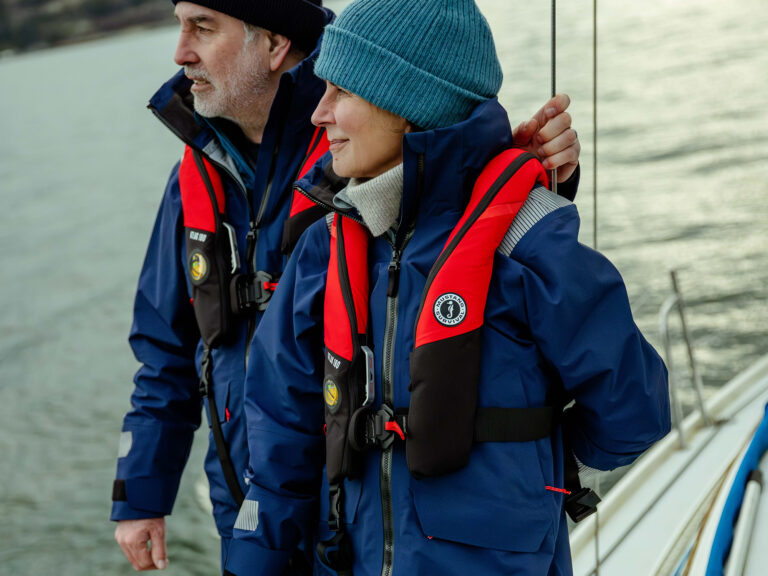When my wife, Alisa, and I set sail from Alaska to Australia on Pelagic, our Crealock 37, our son Elias was 10 months old. By the time our second son, Eric, was born, we were in Tasmania and three years into our life afloat. To accommodate the growing family we traded up to Galactic, a 45-foot steel cutter. The happy chance that we found this new boat in California saw us sailing across the Pacific with a toddler for the second time.
Because we didn’t wait until the kids were “old enough,” Alisa and I gained years of voyaging instead of being stuck ashore in dreaming mode. Our kids have spent their short lives with the beaches of the Pacific as their playgrounds, and they take life on a boat completely for granted. Living on a traveling sailboat, where every day is a shared experience, has given us a closer family life than we would have had ashore, with the parents going off to work and the toddlers going off to day care. To realize these benefits, though, we had to take on the tremendous responsibility of keeping young children safe offshore. As in all aspects of sailing, different things work for different people, but we found a set of approaches that allowed us to look back at our two Pacific crossings with toddlers as the peak experiences of our lives.
Strap ‘Em In, Tie ‘Em Down
The first trouble with toddlers on a sailboat is that they are under the age of reason, so they can’t look out for themselves and can’t follow instructions. This lack of common sense means that young children require elaborate restraints at sea. New parents ashore can simply buy the requisite gear for babyproofing a house, but babyproofing a sailboat requires a bit more ingenuity.
When we were preparing Pelagic, our first goal was to create two places — one abovedecks and one below — where we could leave Elias unattended and know that he was safe. That turned out to be a key modification for sailing with a baby or toddler — our answer to all sorts of “what if” scenarios in which we would be temporarily unable to care for our boy. The spot abovedecks was easy — we were taking a car seat with us for use in port, and through-bolting a handful of eye straps in the cockpit allowed me to securely lash the seat in place. This became a favorite seat for Elias on passage, comfortable no matter the motion of the boat, and his go-to spot when we were anchoring or docking.
The obvious candidate for a safe spot belowdecks is the kid’s bunk, and an escapeproof berth is vital once children start to walk, as it prevents roaming in the middle of the night when adults aren’t looking. We started by cutting off the legs of a folding crib, which then just fit into our forward bunk. I made a cover out of the same netting used on our lifelines to keep Elias from escaping, and all of the basic requirements from the kid’s perspective were satisfied — the crib was comfortable, it was safe and he could be left there unattended. From the parents’ perspective, we ran into problems in port, when we wanted to sleep in the double forward bunk. The crib needed to be set up forward for Elias to fall asleep, and then moved back to the saloon when it was time for the adults to go to sleep a few hours later. It’s hard to explain just how grumpy wrestling the crib would make me at the end of a long, wet day on deck. Suffice it to say, the system only lasted a week. I replaced the crib by creating two baby bunks out of netting, eye straps and carabiners — one up forward in the double, and one inside a lee cloth in the saloon. The baby bunks had enclosures that clipped together and made secure little cages that Elias couldn’t escape, but folded away to nothing when they weren’t in use.
When you do make a bespoke little sea bunk for your baby, though, you’re taking on a lot of responsibility. Land-dwelling Americans buy cribs that have been exhaustively tested to make sure they pose no threat of strangulation. By turning our backs on land life and choosing to rig up string-and-netting lee cloths in our cruising boat, we were also turning our backs on all of the support that society provides in the form of safety standards. Take excruciating care with every detail of your setup and make sure there is no way that your child’s head can fit through any gap — trucker’s hitches are particularly useful for tensioning the lee cloth and eliminating dangerous sags. Going to sea with a young child means that every detail is important. And every detail is your responsibility.
Young children also need secure places to eat and play, regardless of the motion of the boat. This first requirement was easily solved by fastening eye straps to settees in both our boats to make tie-down points for a plastic chair-and-tray combination, designed to tie in to a kitchen chair. Because the saloon table on Pelagic folded away against a bulkhead, that boat had a big enough space for a folding playpen, and, lashed down with the ubiquitous eye straps and padded with settee cushions, it made an ideal spot for Elias to ride out a few thousand miles of coastal sailing as we made our way down the West Coast. By the time we jumped off from Mexico to the Marquesas, the combination of his growing strength and balance and the ever-growing value of storage space on Pelagic saw the playpen eighty-sixed. Our experiences with the crib and the playpen summarize our luck with most standard-issue baby gear: It just doesn’t fit on a midsize monohull. Those little jump-up chairs that attach to a door frame and seem ideal for hanging in a boat’s rigging? They came aboard both our boats, but didn’t last long.
Ironically, Galactic, though a much bigger boat, doesn’t have the open saloon of Pelagic, and so lacks a spot for a playpen. We used eye straps and bungee cord to lash cushions over everything sharp — latches, hinges, locker handles — in the area of the sole where 1-year-old Eric naturally spent most of his time. On both boats, I made baby gates out of netting and eye straps to deny the boys access to the galley and companionway. On Pelagic, I used another stretch of netting to keep Elias from being able to reach the galley stove from the settee. When he wouldn’t stop grabbing the cables running into the backs of our radar and ham radio, we wrapped them in a scrap of Sunbrella fabric and tied them up with eye straps to keep those critical connectors out of his reach.
But! Beware the limitations of all of these baby barriers. In our experience, toddlers can climb before they can do anything else. And their ceaseless development means that they are forever exceeding their previous abilities. You may learn that your little crew are able to get over some critical safety barrier only after they have gotten over it, and found themselves in the danger that they were meant to be out of. Eternal vigilance is the watchword.
On deck, restraining a young child becomes even more important. We strung netting around the cockpit and aft deck of both boats to make secure play areas, but we never relied on the netting alone. Our toddlers always wore harnesses when abovedecks unless they were in the cockpit on a calm day, literally in arm’s reach. Crewsaver makes good harnesses for very young kids, to which we added crotch straps.
Keeping Them Clean
The second issue that distinguishes toddlers on a boat is that they’re not mature enough to use the head. Dealing with diapers afloat is a tractable business. First, cloth diapers are the choice for passagemaking families. There is no way that you want to store weeks’ worth of dirty disposable diapers while on passage. Nor, when you make landfall, do you want to tax the inadequate waste-disposal system of some tropical paradise with your pounds of poopy plastic. So cloth it is. We add a reusable hemp liner for extra absorption.
The great downside of cloth diapers is, of course, washing them. Luckily, running water is effortlessly and endlessly available on passage. Our approach offshore (full disclosure — Alisa’s approach; I didn’t do the diapers) was to dump the bomb inside the diaper overboard and then drag the soiled diaper and liner in a mesh bag behind the boat. A half hour at 6 knots was enough for a thorough first wash. We lashed two five-gallon buckets with lids on deck, each half-full of fresh water and a dash of NapiSan. The diaper went from the mesh bag to the appropriate bucket (one for peed-in diapers, one for bombs) and soaked. Then, every other day, Alisa would rinse all of the soaking diapers and hang them to dry. After months of practice, she was able to rinse two days’ worth of diapers with a quart of fresh water. For cleaning the little one, toilet paper with a bit of lotion offers a biodegradable replacement for baby wipes.
Parent Care
For all the barriers and padding that we added, we found that sailing with a 1-year-old means keeping the child within arm’s reach for most of the waking day. Standing watch becomes more difficult, since one person is often unable both to care for the child and keep a proper watch. If both parents are awake when the child is awake, and take turns standing watch while the child sleeps, exhaustion becomes a real problem. On our first Pacific crossing, we reasoned that sailing with Elias made us de facto singlehanders, since one parent was always required for child care. Of course singlehanders make it where they are going more often than not, in spite of their inability to keep watch. So offshore at night we set our radar alarm to warn us of approaching vessels or squalls and both slept. On our second crossing we didn’t have radar, and we had seen enough tuna boats offshore without AIS that we didn’t want to rely on that technology alone. So we stood watches all through the 10,000 miles between San Francisco and Hobart. We handled the considerable fatigue that resulted, though I’m not sure we could have done it without the experience of one Pacific crossing behind us.
Since having very young crew means that one person will be singlehanding the boat while the other is looking after the child, both parents need to be competent to handle the boat on their own in an emergency. Routine tasks like reefing and jibing need to be one-person affairs. The demands of child care at sea, and the need to make sure someone so dependent comes through the experience just fine, require a very high level of seamanship. We found that young children are completely unfazed by the experience of going to sea, but the psychological demands on the parents are considerable.
Little Steps
So how do you know that you’re ready to take a young family to sea if you’ve got limited experience? With an all-adult crew you can throw yourself at big passages and learn as you go, but with little kids you need to gain experience incrementally to avoid finding yourself in a we’ll-never-do-this-again moment. The very first “passage” we did with Elias was a 5-mile daysail. Before we left Mexico on our first Pacific crossing, we had 3,000 miles of coastal sailing and a handful of passages, up to a week long, behind us as a family. After every trip we found ourselves tweaking our systems for taking care of Elias, so that when the passage to the Marquesas came along we were confident that the whole family could handle three weeks at sea.
Mike Litzow is the author of South from Alaska: Sailing to Australia with a Baby for Crew. Visit Mike’s blog, “Twice in a Lifetime,” at cruisingworld.com/galactic to read more about the Litzow family’s adventures. At press time, Mike and family were exploring Patagonia aboard Galactic.
